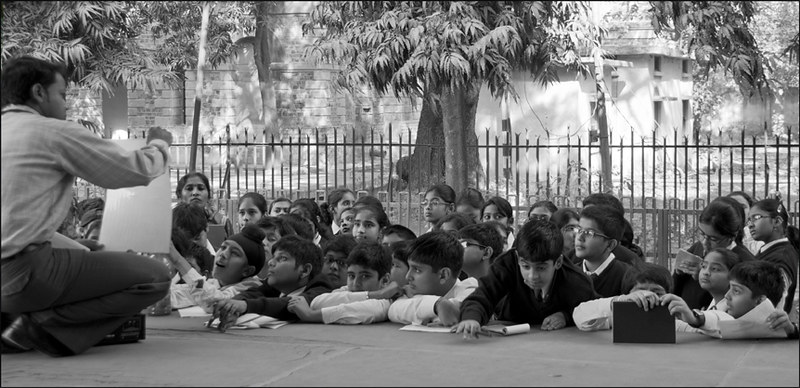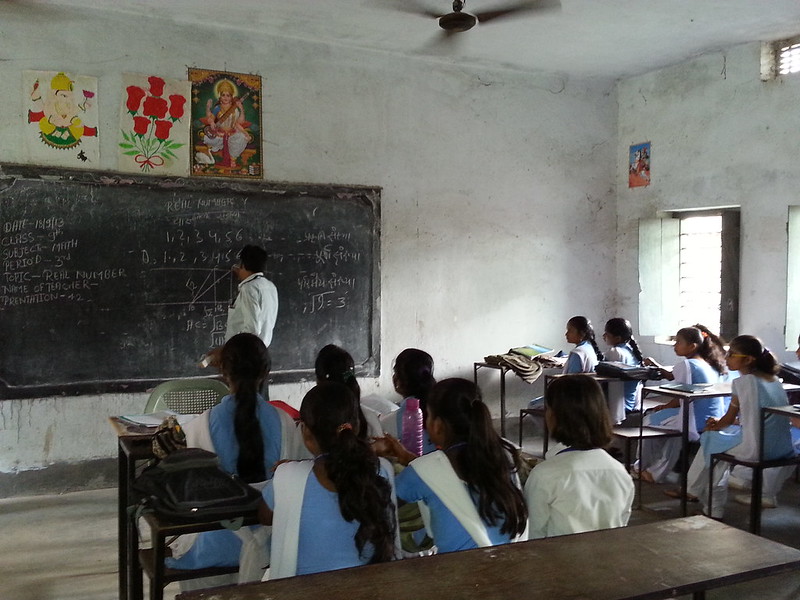You must have heard the famous quote: “He who can, does; he who cannot, teaches.” Popularised by George Bernard Shaw in Maxims for Revolutionists, the quote has added to the popular notion that the teaching profession is the easiest of all. Have you not heard people talking about the perks of being teachers: like getting back home early, or getting long holidays?
Just imagine this though: students from different backgrounds, different learning levels, and different needs packed in a single classroom. One teacher constantly tries to do their best to bring out the best of their students, all day long. Beyond just that, checking assessments, making rigorous lesson plans, collecting resources, following best practices, communicating with parents, and taking care of their students’ overall development are all a part of a teacher’s everyday routine. That’s what just a part of a teacher’s job looks like.
@MHRD step of training 1.2 million schools teachers to spot mental health issues in children. This is necessary considering India is most #depressed country in the world and 6.2 % Indians suffer from some kind of #mentalailment. pic.twitter.com/XBfKK3k1D9
— Dr Meenal Sharma Jagtap (@meenalmona) June 30, 2019
Teachers are accustomed to caring about the social-emotional wellbeing of students and are trained to keep a check on signs of anxiety, depression, bullying, or aggression. Yet they are still just learning how to talk about a huge, hidden threat to their work: their own mental health.
Teaching Can Be Pretty Stressful
Teaching, which comes with the responsibility of shaping young minds, is an extremely gratifying profession; to do it well, a lot of effort goes in. Though a school-day is shorter than a standard office day, teachers put in extra hours after school. Creating an effective lesson plan and finally achieving the “learning-objectives” set out in curriculum frameworks involves many stages. At each stage, a teacher aims to deliver to the best of their teaching abilities.
However, teaching is also about creating a balance between a teacher’s physical and mental health. A study conducted shows that for teachers across schools in West Bengal, 48.72% of teachers who taught in private schools were stressed in comparison to 33.48% of teachers who taught in government schools, with the age group of 56-60 being most affected.
The stress levels of educators are often high, not just in India but across the globe. According to a report by the National Foundation for Educational Research (NFER), in England, 20% of the teachers are tense about their jobs. An important question arises here: what are the triggers for the stress?
First, there are the high demands of their job. Increased attention towards student scores and overall performance has put teachers under enormous pressure, as their teaching ability is measured by student outcomes. In addition, the demanding needs of parents also put pressure on them, especially in the case of new teachers who are adjusting to the work culture and are prone to stress. In India, the problems of low pay and a serious shortage of teachers, build on the stress and anxiety.
Secondly, with the increasing popularity of digital learning, teachers undergo tremendous pressure to create an engaging classroom learning experience. Modern teaching methods involve technology and experiential learning. While using new tools and methods to increase learning outcomes is always encouraging, there is a lack of proper training and resources at the school level, leaving teachers constantly worried about adapting to new technologies and meeting expectations.
You May Also Like: Why Your Teacher Needs To Be Trained Better
The third factor is large class sizes and addressing different learning needs within them. Diversity in the classroom which demands differentiated classroom learning, planning lessons, tracking data, taking assessments, and marking homework increases the workload for a teacher. In a performance-driven world, it becomes increasingly stressful to fulfil the demands of all students while submitting all the deliverables within a limited time. “The increasing workload is a major reason for stress among government teachers. They take care of admissions, manage records, take charge of various events at school, apart from teaching as there is no dedicated staff for any of these activities,” said a Teacher For India Fellow in Bangalore.
Much needed, all teachers irrespective of what level they teach should be trained in basics of counseling. Sadly, with a huge dearth of mental health professionals to conduct such training, the capacity in India for that is too low. https://t.co/Hezmpjthmy
— Sambit Dash (@sambit_dash) December 7, 2018
Fourthly, disruptive student behaviour can create tension in a classroom, thus pushing learning to the backseat. This behaviour impacts more than just the student involved, which makes the learning atmosphere destructive. The lack of training in classroom management strategies makes the situation even worse.
Lastly, the concept of counseling of teachers is hardly known at the school level. Not many schools form teacher support groups or provide the resources required by teachers such as time for preparation, assistant teachers, materials to teach, and help for professional development. These are essential, not only to ease the stress and burnout of teachers, but also, to help students learn better. “The training we receive is mostly about how to teach content, but there is hardly any training or counseling for teachers’ mental health. Apart from a few organisations that are spreading awareness about students’ mental health, nothing is done at the school level,” said M. Arthi, working as a teacher in a government school in Bangalore.
Teacher- Student Mental Health: A Two Way Street
Why is focusing on teachers’ mental health so important though? An educators’ mental health is one of the biggest factors in a students’ academic growth, as the mental health of teachers and students are interconnected, thus directly affecting their learning and outcomes. While providing quality education is imperative, it is also essential that teachers develop a strong emotional bond with their students. Only when a teacher knows how to support their own mental wellbeing, will they be able to provide a supportive learning environment. The burnout feeling among teachers, which is a low and stressed state of the mind, could be contagious. It affects not only educators but also the students with whom these educators interact. The general consensus was that to be fully effective teachers need to be in good mental health.
However, School Mental Health (SMH) is nearly non-existent in India and the path of enactment sees many stumbling blocks. A general tendency of policy-makers to only see mental health as an all or nothing situation. Addressing the subtleties of mental health and spreading awareness has never been easy.
There is a general lack of recognition on the importance of mental health and basic mental healthcare practices, such as stress management training, provision of counseling services or incorporation of self-care practices into everyday schedules, to ensure the mental well being of both students and teachers. The acute scarcity of trained mental health professionals is one of the main challenges. While a few organisations like Indian Mental Health and Research Centre (IMHRC), The Minds Foundation, and The Banyan in India have taken initiatives for the mental wellbeing of students, no one is addressing the mental health of the most critical stakeholder: teachers, who are responsible for providing quality education that the country aims for. What can be done then?
Moving Ahead
Firstly, the school has an important role to play to help teachers teach effectively. School authorities can set up workshops and support programmes to minimize teacher stress before it becomes overwhelming down the line. Training and awareness programmes about common mental health issues can also improve the health outcomes of students and teachers, and help reduce anxiety.

“There are hundreds of reasons for building up stress in school and classroom. Understanding the importance of teachers’ mental wellbeing, we have been conducting regular counseling sessions and workshops for teachers. The workshops include activities and reflections which help reduce their stress and anxiety,” said Mahima Kushwaha, a counselor at Shri Aurobindo Ashram, Puducherry.
Secondly, building teacher support groups to help each other may reduce a great amount of stress. Establishing strong communication channels among teachers for sharing best practices and resources can prove to be extremely helpful for teachers. Prioritising and organising such groups is the key to achieving the best results at a personal level.
Thirdly, Central and state governments need to take actions like appointing counselors in each school, including ‘School Mental Health (SMH)’ in school curriculum, and conducting regular mental health sessions for both students and teachers to make the dream of ‘quality education for all children’, a reality.
Teachers have a formative role in the development of their students. Yet our ability to truly provide tangible assets for their mental health management, who are being overburdened and stretched thin, has become a different ball game altogether. Amid all the talk about mental health, creating supportive classrooms and schools that recognise educators’ mental health issues are still a long-term goal. The wellness of educators is a far-reaching crisis that clearly requires comprehensive action for India to reach its education goals.
Featured image courtesy of TESS India, (CC BY-SA 2.0)







[…] We Need To Start Talking About Teachers’ Mental Health […]
HRD Ministry please do something to help teachers too for their physical and mental well-being. Teachers are too burdened with this online classes and assignments as there are too many expectations from all quarters. They have to stay up late in the night preparing for the next day. Be considerate and realise that a teacher is a human and not a machine. He or she has a home and a family like everyone. Honestly speaking this load is taking a toll on their health physically and mentally. Give a serious thought and be humane.
Teaching no doubt is a stressful job.It does work on the mental health of a person as i have personal experience due to the excess useless policies through management’s and overburdened with the time table I very often felt like as though I am a useless nit wit but my confidence always came back when my students reassured how thankful they were and this kept me going .I felt I was on the right track.
I have seen not many teachers are dedicated its like a way of getting out of the house .This I talk of the social set up of our society.Mostly teachers are women and no professionals. Many a times teaching is so deplorable that its a pity. India to have a good education system wher good learning skills are to be imparted the rat race for students to score 95 plus has to be stop somewhere .Getting into college marks so the stress rises its a chain .Parents stress out the child ,the management’s stress out the teacher. Marks are given priority.If one looks deep its a chain reactions to score well or you won’t get admission in a college. I can keep on on talking about this one issue to the next. The issue raised is worth giving a thought.
A teacher is a role model who inspires and encourages us to strive for greatness, A teacher has many responsibilities which keeps them busy all day, due to which they have no time to care themselves . Realy feel good to see this article . Hats off to the Teachers.
The teachers are working tirelessly even during this pandemic but who thinks about them.
Very happy to see this article addressing a n issue that is not discussed at all. I think teachers today have such a tough time with demanding parents, not so well disciplined children, remuneration and lack of recognition.
Is there a gender bias? There are a lot of women in the teaching profession, and often job going home and work is stressful enough.
A sensitive article!